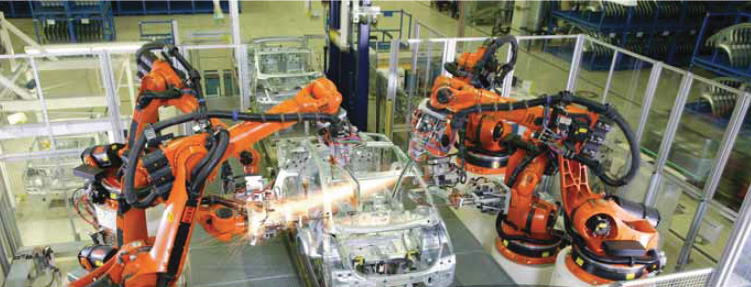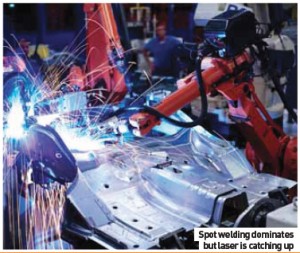
As a consequence of this realisation, spot welding has enjoyed something of renaissance in terms of process development. At TWI (The Welding Institute) in the UK, the backbone of the organisation’s knowledge in automotive manufacture is built around the core joining technologies, at the forefront of which is SmartDress – a current project focussing on improving the performance of resistance spot welding.
SmartDress (www.smartdress-project.eu) is a consortiumbased project funded by the EC under Framework 7 and  supported by a team of leading research/training institutions and European-based SMEs, all seeking to improve the reliability and efficiency of resistance spot welding. On automotive production lines a major cause of line stoppages are spot weld quality issues, and these usually arise from poor maintenance of consumable electrode tips on RSW guns.
supported by a team of leading research/training institutions and European-based SMEs, all seeking to improve the reliability and efficiency of resistance spot welding. On automotive production lines a major cause of line stoppages are spot weld quality issues, and these usually arise from poor maintenance of consumable electrode tips on RSW guns.
Dressers are commonly utilised in an attempt to maintain tip quality, however, existing systems require manual set-up, optimisation and continued monitoring during production. With a vehicle typically rolling off a production line every 1-2 minutes, a tip dress issue causing even a 5 minute line stoppage once a day can result in a loss of 10 vehicles per week, equating to around €7 million of lost revenue per annum for an average production line, says TWI. SmartDress aims to develop an automated adaptive control system that will optimise, monitor and maintain electrode tip quality. The system will increase the production life of electrodes by a factor of two.
Another key feature of SmartDress will be to allow costcompetitive spot welding of aluminium, which OEMs presently consider to be commercially unviable. Dr Srinivas Nidamarthi, Technology Manager for Robots Systems at ABB Robotics, agrees that spot welding will retain its place as the premier body-in-white joining technology, in the near future at least.
“Initially, new and alternative joining techniques tend to be niche applications. I don’t see them taking the place of spot welding very soon, for example, as car designs are already in place for the next 10 years, through 2020,” he says. He adds that in modern cars, the body-in-white features between 15 and 20 different joining technologies, but the leading automated process remains spot welding, commanding anywhere between 30-60% of all joins.
TWI is currently researching the laser welding of lap joints in press hardened steels, examining the interactions between laser spot diameter and process speed. It has been shown that slower process speeds and larger spot diameters produce a wider joint at the sheet interface. The wider joints also have signifi cantly lower hardness, which result from slower cooling rates.The mechanical strength of such joints is also being investigated using tensile shear specimens. It has been found that when the approach of producing wider joints with lower hardness is tested, a 60% increase in weld strength can be obtained. The disadvantage of this strategy is reduced production speed, but when a high integrity joint is required for crash performance, the benefi ts can be significant.
Kuka Systems has been successful in securing an order for the Volvo S60 as part of a new assembly line at the automaker’s Gothenburg plant. The new line is to be integrated without shutting down the existing operation. In addition to engineering the complete line, Kuka will be responsible for developing and manufacturing new jigs, fi xtures and grippers to assemble the side panels, doors, hood and trunk lid of the premium class sedan. The contract also includes the extension of the framing station to produce the body-in-white. Industrial robots will be used to automate the entire line. The processes involved are spot welding, gluing and handling tasks, together with arc welding and bolt tightening on the body-in-white. Kuka expects to complete the project by the end of the autumn 2012.
Retaining the theme of automated spot welding, among Kawasaki’s latest body-in-white welding technologies is the development of next-generation BX robots. According to Kawasaki, the new BX range offers more welds per cycle – up to 20% faster on average, with up to 50% less installation space requirement.
“We’ve had strong interest and initial orders totalling in the hundreds of units from OEMs and Tier One suppliers,” says Yanik Van Coppenolle, Marketing Specialist at Kawasaki Robotics (USA) Inc. Available in two models, offering 100 and 200kg payload capacity, these optimised body shop robots ar said to excel at high speed shor movements. The improved seq by the servo welding guns, alon calibration, optimise acceleration gun speed, leading to cycle tim The BX-Series is manufactur reduction units for the upper a dressing of the robot from the mounting plate. With Kawasak package, the manufacturing lin engineering time is reduced.
AC welding users have proved reluctant to embrace the concept of adaptive welding but, with industry facing relentless cost reduction pressures, that could be about to change, says Bosch Rexroth. AC resistance spot welding is still used in many automotive processes, but as manufacturing engineers know, the process is prone to weld disturbance. This can include shunting, caused by AC paths leading to a loss of energy, bad fi tting of sheets and variations of coating and sheet thickness. The setting of weld parameters is crucial in obtaining a good weld. Too much energy creates weld ‘splash’, while too little can promote weld failure. An adaptive system can assist in setting weld parameters by giving far greater visibility in identifying the programs that exhibit splash. It also allows for the setting of cooler weld conditions, with the operator being confi dent that if disturbances to the weld process occur, the regulator will adapt accordingly to prevent weld failure. The vital component in the Rexroth adaptive welding system is the U (voltage) I (current) regulator. The regulator takes inputs from either the primary or secondary current, as well as a voltage tap on the electrodes. Dynamic resistance during the weld is calculated from the sensed current and voltage. The UI regulator compares the values for the actual and reference resistance every millisecond. If there are differences, the regulator adjusts the weld current accordingly.
By coupling all axes of the scanner with those of the robot as a guiding machine, the system commands a total of nine selectable axes. Regardless of whether the application is spot, circular, wave or stitching seams – the seam geometry is freely programmable and can therefore be adjusted to strength and component requirements. Rapid arrival at the next welding position is supplemented by quick rotating mirrors in the scanner head that enable fast positioning of the laser beam within the working field. Robot movement and speed can be optimised by optional offline programming, while software functions also calculate robot path inaccuracies as the current position is reported back within the operational cycle. Thus, repeat accuracies in the range of <0.2mm are possible.
Last but not least, the new scanner head doesn’t need an expensive flat field lens, making it an even more appealing solution for scanner welding in the harsh environment of the auto plant.
Despite the ongoing use of spot welding, there is no doubting the influence of laser technology on current bodyin- white developments. Laserline GmbH says the advantages of laser brazing with filler wire, for example, are most apparent when used in Class A show surfaces. Low warp, a stiff joint ready for the paint shop and almost no postprocessing makes it an attractive proposition. According to Laserline, compared with laser or spot welding, laser brazing improves the aesthetics of a joint so substantially that the usual plastic strip needed to cover it can be omitted. Using fibre-coupled, lamp pumped, Nd:YAG laser technology, laser brazing can achieve a typical process speed of around 2.4 m/min, but the advent of the latest fibre coupled diode lasers, fibre lasers, or disk lasers (all diodebased) have led to a step change in this area.
Getting an insight into a weld controller using a standard web browser from a computer, a robot teach pendant, a PLC or a smart phone is now becoming a reality. ARO Welding Technologies has developed an embedded web server on its MFDC weld controllers, which host web pages showing key process parameters and weld results. Data access is of course subject to password protection. Major benefi ts can be found in robotised or automated production cells where graphic HMIs are already present.
Fused with advantagesTrumpf is another technology supplier with a vested interest in laser-based joining technologies. The company has an extensive list of auto OEM users for its laser welding products, the motivation for which, says the company, includes smaller flanges – typically 8mm wide against 14.5mm needed for spot welding. Less weight, higher stiffness and lower heat input are also influencing factors. According to Trumpf, the big driver behind the growing trend of remote welding is the minimisation of nonproductive travelling time although, of course, the success of such a process is very much material dependent. With new materials being approved for automotive use with unerring frequency, process evolution is essential. In one current example, Trumpf has been working with Novelis on the remote laser welding (without additional wire) of ‘Fusion’ – an aluminium sheet innovation composed of multiple alloy layers. Featuring a clean and oxide-free interface between the layers, the material has been developed to serve customers who increasingly require alloys that combine the properties of strength, lightweight characteristics and formability. Conventional 6000 series aluminium alloys are known to exhibit hot cracking sensitivity during remote laser welding. This is due to the columnar grain structure in the welded zone linked with the slight amount of magnesium, silicon and/or copper in the material. As a result, welding can only be successfully performed with filler material and/or low welding speed.
However, Novelis Fusion Alloy 8840 features a specific cladding that makes it possible to weld without filler metal, and without any hot cracking. The material maintains all the advantages of 6000 series monolithic alloys, is compatible with remote laser welding (no gas protection) and is fully approved for automotive applications. Trials were successful in various edge preparations, including butt, overlap and T-joint, even with a minimum weld flange distance as small as 5mm.
Trumpf is also involved in case studies of laser-arc hybrid welding of aluminium body parts such as axle carriers. Here, the combination of laser and MIG offer better quality (laser introduces process stability) and gap behaviour (MIG is effective at bridging gaps), along with up to three times higher speed compared with MIG alone. As material technologies advance, there is a clear decision for OEMs to make: either adapt existing joining technologies or seek out new methodologies and processes intended to accommodate these trends. Spot welding is showing resilience, but few can doubt the continued advance of laserbased alternatives in the joining mix.




































